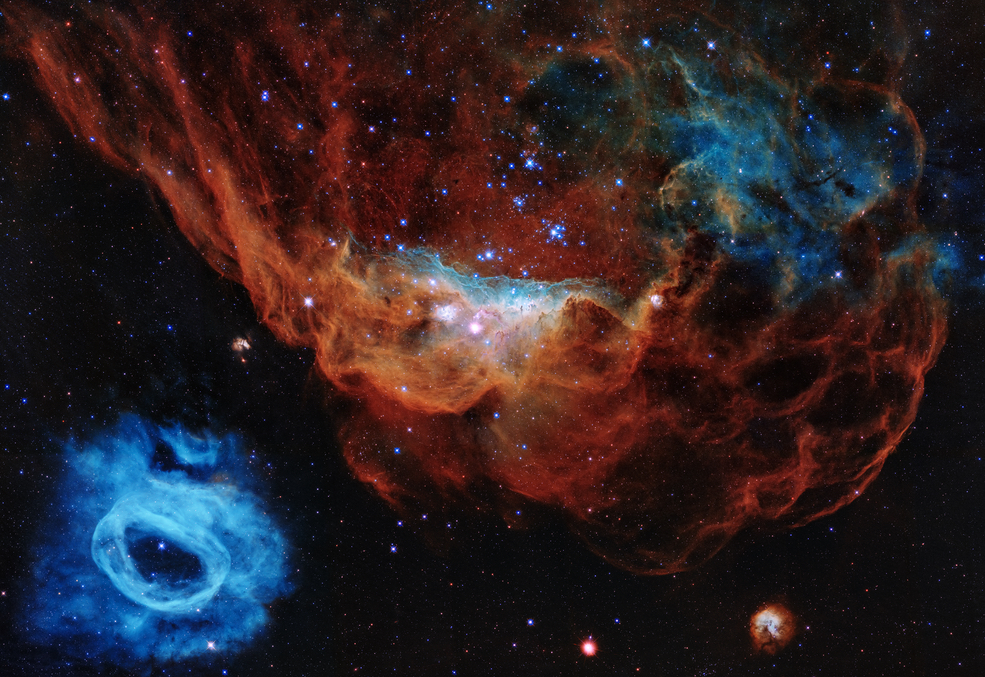NASA reveals stunning 'Cosmic Reef' blasting to life in nearby galaxy
Two bright nebulas in a galaxy 163,000 light-years away are very pregnant with stars.

Young stars blaze to life in a nearby galaxy, repainting their cosmic neighborhood with fiery blooms of gas and radiation.
This new Hubble Space Telescope image captures just another day in the life of two young nebulas (one red, one blue) in the Large Magellanic Cloud, a satellite galaxy of the Milky Way located about 163,000 light-years away. But for scientists and space enthusiasts on Earth, the image also marks a special anniversary. Thirty years ago today (April 24), the Hubble launched from NASA's Kennedy Space Center in Florida to begin its long mission of peering into the deepest reaches of space.
While the Hubble has since homed in on galaxies from the earliest days of the universe, the telescope didn't have to look too far to capture this stunning starscape. As a satellite of the Milky Way, the Large Magellanic Cloud (LMC) is close enough to be caught in the thrall of our galaxy's gravity, and it inches a little bit closer to our galaxy every year. (Scientists actually think the neighboring galaxy will crash into ours in the next few billion years or so.)
Related: Hubble image reveals the mighty baby stars that will probably destroy the 'Pillars of Creation'
With about 5% the mass of the Milky Way, the LMC contains many regions where baby stars are still actively forming. The nebulas shown in this Hubble image represent two such "stellar nurseries," according to a statement from NASA.
These baby stars are big — at least 10 times more massive than Earth's sun — and they're bright. The star at the center of the blue nebula in the bottom left corner of the image is about 200,000 times brighter than our sun, Jennifer Wiseman, a senior scientist on the Hubble Project, said in a video accompanying the image.
"Powerful radiation from these stars is causing the surrounding gas to glow in stunning colors," Wiseman said. "Those massive stars are also driving powerful winds of charged particles, which are sculpting out the bubble and ridge structures we can see across the nebula."
Get the world’s most fascinating discoveries delivered straight to your inbox.
NASA researchers have nicknamed this image the "Cosmic Reef" for its resemblance to a coral reef in Earth's oceans — bursting with color and life, but hidden just beyond the reach of human sight.
- 9 Epic Space Discoveries You Probably Missed in 2019
- The 15 weirdest galaxies in our universe
- The 12 strangest objects in the universe
Originally published on Live Science.
OFFER: Save 45% on 'How It Works' 'All About Space' and 'All About History'!
For a limited time, you can take out a digital subscription to any of our best-selling science magazines for just $2.38 per month, or 45% off the standard price for the first three months.

Brandon is the space / physics editor at Live Science. With more than 20 years of editorial experience, his writing has appeared in The Washington Post, Reader's Digest, CBS.com, the Richard Dawkins Foundation website and other outlets. He holds a bachelor's degree in creative writing from the University of Arizona, with minors in journalism and media arts. His interests include black holes, asteroids and comets, and the search for extraterrestrial life.



